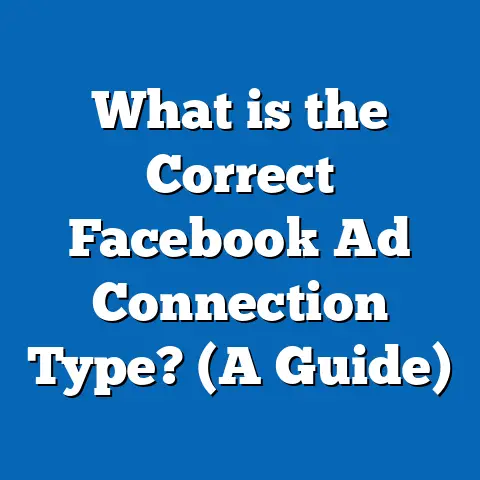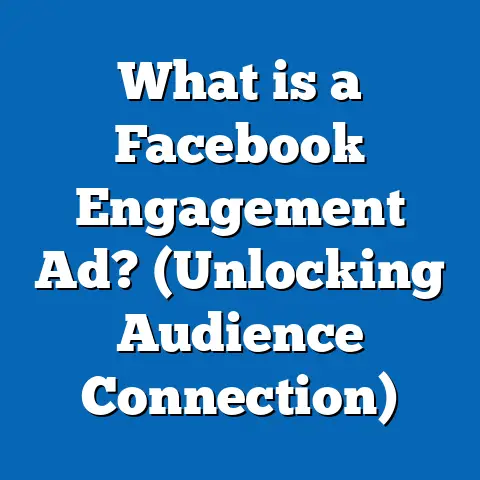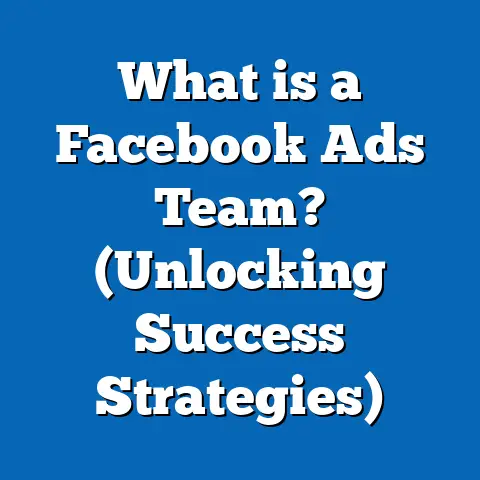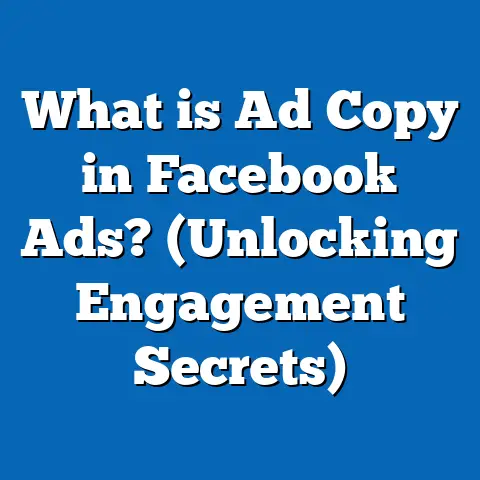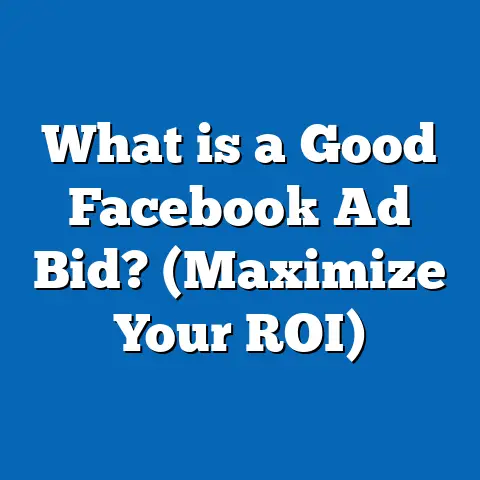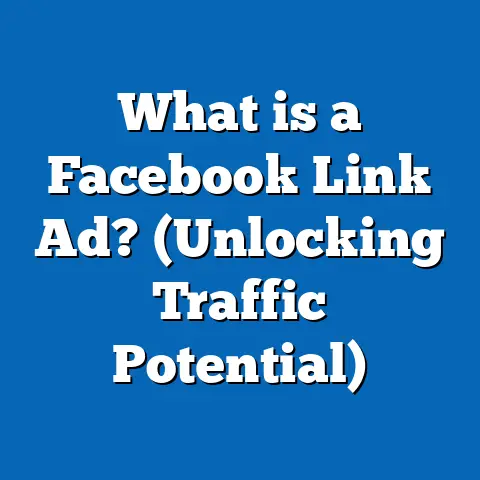What is a Facebook Ad Set? (Unlocking Targeted Strategies)
What is a Facebook Ad Set? (Unlocking Targeted Strategies)
Introduction: The Comfort of Precision in Advertising
In the constantly evolving landscape of digital marketing, comfort for businesses and marketers comes from having control and clarity over their advertising efforts. Imagine being able to deliver your message not just broadly but precisely—right to the people who are most likely to engage, buy, or become loyal customers. In this world of noise and competition, Facebook Ads have emerged as a game-changer by offering unprecedented targeting options. At the core of this powerful system is the Facebook Ad Set—a tool that allows you to fine-tune your audience, budget, placements, and schedules for optimal results.
Understanding what a Facebook Ad Set is and how to use it effectively can dramatically change your advertising outcomes. Whether you’re a small business owner seeking local customers or a marketer running multi-million dollar campaigns, mastering Ad Sets gives you the comfort of knowing your ads reach the right people under the best conditions.
Facebook Advertising Campaign Structure: The Framework for Success
To fully grasp the importance of Facebook Ad Sets, it’s essential to understand the three-tier structure of Facebook advertising:
- Campaign: The highest level where you select your advertising objective, such as brand awareness, lead generation, conversions, or app installs.
- Ad Set: The middle layer where detailed targeting, budget allocation, scheduling, bidding strategy, and placements are defined.
- Ads: The creative units that users see—images, videos, carousel posts, and text.
This hierarchical model allows businesses to organize and optimize campaigns systematically. If the campaign is the blueprint for success, the Ad Set is the control center where strategic decisions are made that impact performance directly.
Defining a Facebook Ad Set: The Engine of Targeted Advertising
A Facebook Ad Set is more than just a configuration box; it’s where you specify:
- Who will see your ads (audience targeting)
- How much you want to spend (budget)
- When your ads run (scheduling)
- Where your ads appear (placements)
- How Facebook optimizes delivery (optimization goals and bidding)
In simple terms, an Ad Set allows you to segment your audience into distinct groups with tailored budgets and strategies. This level of granularity means you can test different approaches side-by-side within the same campaign and identify what works best.
Why Focus on Facebook Ad Sets? Data-Driven Insights
The Power of Segmentation
According to Facebook’s own research:
- Advertisers who run multiple targeted Ad Sets experience an average 37% improvement in Return on Ad Spend (ROAS) compared to those using broad targeting.
- Businesses optimizing Ad Sets for conversion objectives have reported a 20% reduction in Cost Per Acquisition (CPA).
- With over 2.91 billion monthly active users on Facebook alone (including Instagram), advertisers have access to one of the most granular targeting ecosystems in digital marketing history.
Industry Case Study Snapshot
A global e-commerce company used segmented Ad Sets to target different buyer personas based on purchase behavior and location. By refining each group’s budget and messaging within its own Ad Set:
- They increased ad relevance scores by 25%
- Reduced CPA by 18%
- Boosted overall sales by 32% within three months
This data underscores why understanding and optimizing Ad Sets is crucial.
Components of a Facebook Ad Set Explained
Let’s break down each critical component of an Ad Set to understand how it shapes campaign performance.
1. Audience Targeting: Crafting Your Ideal Customer Profile
Facebook’s strength lies in its unmatched targeting capabilities. Within an Ad Set, you can define audiences based on:
Core Audiences
Core audiences include:
- Demographics: age, gender, education, relationship status
- Location: country, state, city, radius targeting
- Interests: pages liked, hobbies, entertainment preferences
- Behaviors: purchase behavior, device usage
Example: An online sportswear brand targets men aged 18-35 interested in marathon running living within 50 miles of major urban centers.
Custom Audiences
Custom Audiences allow you to upload lists of existing customers or leads or retarget users who interacted with your website or app.
Data Insight: Ads targeted at Custom Audiences achieve an average CTR of 2.3%, significantly higher than broad targeting at 0.9%.
Lookalike Audiences
Lookalike Audiences find new prospects by identifying users similar to your best customers based on behavior and demographic patterns.
Practical Tip: Use Lookalike Audiences when scaling campaigns after validating your core audience segments.
2. Budget and Bidding: Controlling Spend for Maximum Efficiency
Within each Ad Set, you control how much money Facebook spends and how it bids for ad placements.
Budget Types:
- Daily Budget: Set a fixed amount to spend each day.
- Lifetime Budget: Set a total spend amount over the whole campaign duration.
Bidding Strategies:
- Lowest Cost (Automatic): Facebook aims to get the most results at the lowest cost.
- Cost Cap: You set a maximum CPA goal to maintain profitability.
- Bid Cap: You limit how much Facebook can bid per impression or click.
Insight: Advertisers using cost cap bidding report up to 15% better control over costs while maintaining volume.
Example: A SaaS company sets a cost cap bid on sign-ups at $10 per acquisition to ensure profitability.
3. Placements: Deciding Where Your Ads Appear
Facebook offers multiple ad placements across its family of apps and services:
- Facebook News Feed
- Instagram Feed
- Stories (Facebook & Instagram)
- Audience Network (third-party apps)
- Messenger
You can choose:
- Automatic Placements (recommended): Facebook optimizes delivery across all available placements.
- Manual Placements: Select specific platforms or devices.
Key Stat: Advertisers using automatic placements have seen up to a 20% increase in reach at similar or lower costs compared to manual placements.
4. Scheduling: Timing Your Ads for Maximum Impact
Scheduling within an Ad Set lets you determine when your ads run:
- Continuous delivery starting immediately
- Specific start and stop dates
- Dayparting (running ads only during certain hours or days)
Example: A restaurant runs ads only during lunch hours and weekends to maximize reservations.
5. Optimization & Delivery
You also select what event or action Facebook should optimize for within each Ad Set:
- Link clicks
- Impressions
- Conversions
- Engagement
- Video views
Choosing the right optimization goal affects how Facebook distributes your ads for best performance.
Data Point: Optimizing for conversions reduces CPA by an average of 20% compared to optimizing for link clicks.
Advanced Strategies for Maximizing Facebook Ad Sets
Split Testing / A/B Testing at the Ad Set Level
Split testing allows marketers to create multiple Ad Sets with variations in one key element such as audience targeting or budget. This method helps identify which approach delivers better ROI.
How to Run Effective Split Tests:
- Change only one variable at a time per test (e.g., audience age group).
- Keep budgets equal for fair comparison.
- Test at least 7 days for significant data.
- Analyze metrics like CTR, CPA, ROAS.
Example: An e-commerce brand tests two audiences—women aged 25-34 vs men aged 35-44—to determine who responds better to a new product launch.
Layered Targeting: Combining Multiple Filters
Layering allows combining demographics, interests, and behaviors to narrow down highly specific audiences.
Example: Target women aged 30-45 interested in yoga AND organic skincare products AND living in urban areas.
Caution:
Over-layering can reduce audience size too much (<1,000 people) leading to poor ad delivery and higher costs.
Retargeting Campaigns Using Custom Audiences
Retargeting focuses on users who have already interacted with your brand but haven’t converted yet. This strategy can be implemented via dedicated Ad Sets with custom audiences such as:
- Website visitors last 30 days
- Customers who abandoned shopping carts
- App users who haven’t engaged recently
Case Study: A fashion retailer saw a 70% higher conversion rate from retargeting campaigns compared to cold prospecting campaigns.
Dynamic Creative Ads Within Ad Sets
Dynamic Creative automatically combines multiple headlines, images/videos, and descriptions within an Ad Set to find the best performing ad combinations without manual creation.
Benefit: Saves time and improves ad relevance through automatic optimization.
Geographic & Language Targeting Nuances
For international campaigns or local businesses with multilingual audiences:
- Use separate Ad Sets by country or language.
- Customize creative messaging per region.
Example: A travel agency runs one Ad Set targeting English speakers in Canada and another targeting French speakers in Quebec with localized creatives.
In-depth Case Study: Multi-Ad Set Strategy Boosts ROI for Local Business
Business: Urban Fitness Club
Objective: Increase memberships
Campaign Setup: One campaign with three distinct Ad Sets:
- Local Interest-Based Targeting: Women aged 25–40 interested in Pilates within 10 miles radius
- Retargeting: Website visitors who browsed membership page last 14 days
- Lookalike Audience: Based on previous members’ profiles
Budget Allocation: Equal budget split initially; adjusted based on performance after 10 days.
Results After One Month:
Comparing Facebook Ad Sets with Other Platforms’ Structures
| Feature | Facebook Ad Sets | Google Ads Campaigns | LinkedIn Campaign Groups |
|---|---|---|---|
| Audience Targeting | Demographics, Interests, Behaviors | Keywords + Demographics | Job Titles, Company Size |
| Budget Control | Per Ad Set | Per Campaign / Ad Group | Per Campaign |
| Placements | Multi-platform (Facebook family) | Search & Display Network | LinkedIn Feed & Messaging |
| Testing Capability | Built-in A/B Testing | Limited native split testing | Basic Experimentation |
| Optimization Focus | Events like conversions or clicks | Keyword relevance & bids | Lead generation & engagement |
Facebook’s granular audience control combined with multi-platform placements offers unique flexibility compared to keyword-focused Google Ads or professional network LinkedIn.
Latest Trends Impacting Facebook Ad Sets in 2024
AI-Powered Audience Suggestions
Facebook now provides AI-driven audience recommendations during Ad Set creation that can increase engagement rates by up to 12% by suggesting lookalikes or interest groups you may not have considered.
Campaign Budget Optimization (CBO)
While CBO allows automatic budget distribution across all Ad Sets within a campaign based on performance, many marketers still prefer setting budgets individually at the Ad Set level for precise control.
Increased Focus on Video & Interactive Ads
Video ads in targeted Ad Sets have shown an average engagement uplift of 30%, making video creative a priority for advertisers focusing on brand awareness and conversions alike.
Privacy Changes & Data Limitations
Ongoing privacy regulations (GDPR, CCPA) and iOS tracking changes have led to approximately 15% reduction in custom audience sizes, pushing marketers toward broader targeting combined with layered interest strategies within multiple Ad Sets.
Step-by-Step Guide: Setting Up an Effective Facebook Ad Set
Step 1: Define Your Objective at Campaign Level
Choose objectives like conversions, traffic, or lead generation based on business goals.
Step 2: Create Distinct Audience Segments
Use Core Audiences for broad reach; Custom Audiences for retargeting; Lookalike Audiences for scaling.
Step 3: Decide Your Budget & Bidding Strategy
Set daily or lifetime budgets; choose cost control bidding if CPA stability is essential.
Step 4: Select Placements
Use automatic placements initially; refine manually after reviewing performance data.
Step 5: Schedule Your Ads Strategically
Choose continuous or time-bound schedules matching customer behavior patterns.
Step 6: Optimize for Desired Actions
Pick conversion events or link clicks based on funnel stage focus.
Step 7: Launch & Monitor Performance
Review key metrics daily; pause underperforming Ad Sets; reallocate budget dynamically.
Common Mistakes to Avoid When Using Facebook Ad Sets
- Overly Narrow Targeting: Leads to small audience size and high CPM.
- Ignoring Split Testing: Missing out on optimization opportunities.
- Setting Budgets Too Low: Prevents algorithm learning.
- Not Using Retargeting: Missing high-converting warm audiences.
- Neglecting Creative Variation: Leads to ad fatigue and lower CTR.
- Running Ads Continuously Without Monitoring: Wastes budget on poor performers.
- Ignoring Placement Performance: Some placements may underperform depending on your product/audience.
- Not Adjusting Bidding According to Goals: Using lowest cost bidding when CPA control is needed can increase costs unnecessarily.
Practical Examples of Successful Facebook Ad Sets Across Industries
Example 1: E-commerce Brand Launching New Product Line
- Multiple Ad Sets targeting different age groups and interests related to product categories.
- Use of Custom Audiences retargeting website visitors plus Lookalike Audience scaling.
- Budget allocated based on early performance data with weekly adjustments.
Result: 25% lift in sales within first two weeks; CPA reduced by 18%.
Example 2: SaaS Company Driving Free Trial Sign-Ups
- Two main Ad Sets:
- Retarget past website visitors who viewed pricing page.
- New prospect Lookalike Audience based on current customers.
Optimization goal set to “Conversions” focused on sign-up event.
Result: Cost per trial reduced by 22%; free trial sign-ups increased by 40%.
Example 3: Local Restaurant Increasing Reservations
- Geo-targeted radius-based audience within 5 miles.
- Scheduled ads during lunch/dinner peak hours only.
- Separate Retargeting Ad Set for website visitors who viewed menu page.
Result: Reservation increase by 30% during campaign period; ad spend efficiency improved by 26%.
Measuring Success at the Facebook Ad Set Level
To ensure your campaigns deliver optimal results, track these key metrics for each Ad Set:
| Metric | What It Measures | Why It Matters |
|---|---|---|
| CTR | Click-through rate | Indicates ad relevance |
| CPC | Cost per click | Measures cost efficiency |
| CPA | Cost per acquisition | Key metric for ROI |
| ROAS | Return on ad spend | Overall profitability |
| Frequency | Average times an ad is shown | Avoids ad fatigue |
| Relevance Score* | Quality & engagement indicator | Impacts ad delivery & cost |
Note: Facebook replaced relevance score with quality ranking metrics but similar principles apply.
Future Outlook: The Evolving Role of Facebook Ad Sets
As automation and AI become more embedded in advertising platforms:
- Expect more AI-driven automatic audience segmentation inside Ad Sets.
- Greater integration with e-commerce platforms will enable dynamic product-specific targeting within multiple segmented Ad Sets.
- Privacy-compliant solutions will push marketers toward broader yet smarter layered targeting strategies.
Keeping pace with these changes means mastering foundational concepts today while staying agile tomorrow.
Summary & Actionable Next Steps
Summary:
- The Facebook Ad Set is the critical middle layer controlling targeting, budget, schedule, placements, and optimization.
- Proper use of multiple targeted Ad Sets improves ROAS and reduces costs significantly.
- Advanced tactics like split testing, layered targeting, retargeting, and dynamic creatives enhance campaign performance.
- Staying updated on platform trends and privacy impacts is vital.
Next Steps:
- Review your current campaigns’ use of Ad Sets—are you segmenting enough?
- Create new segmented Ad Sets targeting various customer personas or behaviors.
- Experiment with bidding strategies and placements within each Ad Set.
- Use Facebook’s A/B testing tools regularly.
- Monitor performance metrics weekly and optimize budgets accordingly.
- Incorporate retargeting as a core strategy via custom audience-based Ad Sets.
- Stay informed about platform changes impacting targeting options.
Master these elements to unlock precision-driven advertising that delivers measurable business growth on Facebook’s powerful platform.

